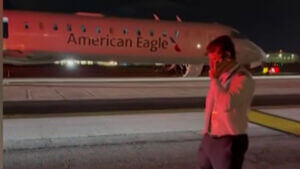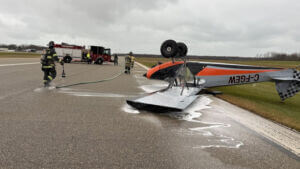Today we celebrate Thanksgiving Day.
On this day we are reminded of the bounty of treasures that are a part of our lives. We spend a few moments before the Thanksgiving dinner to give thanks for the richness of our lives and for our wonderful family and friends.
treasures that are a part of our lives. We spend a few moments before the Thanksgiving dinner to give thanks for the richness of our lives and for our wonderful family and friends.
My list of thanks includes my wife Fionnuala, my family, my friends, and those who keep me free and safe both at home and abroad be they fireman, policeman, EMS or soldier.
I wish all personnel in the Public Safety sector and specifically the Aircraft Rescue and Firefighting community a very happy, and safe Thanksgiving holiday.
I also give thanks and offer a prayer to keep safe all those in the military that are standing a post today to ensure the safety and security of all of us!
Everybody have a Safe and Happy Thanksgiving!
Tom
-
Mechanical issue prompts evacuation from American Airlines flight in Philadelphia
Passengers hoping to travel for Thanksgiving found themselves stranded overnight in Philadelphia after a mechanical issue forced an American Airlines flight to stop its departure late Wednesday.
By Cherise Lynch and Lili Zheng
Passengers on an American Airlines flight are stuck in Philadelphia on Thanksgiving Day after a mechanical issue forced them off their plane in the middle of the night.
in Philadelphia on Thanksgiving Day after a mechanical issue forced them off their plane in the middle of the night.
According to officials, this all unfolded around 10 p.m. on Wednesday, November 26, 2025, on the tarmac at Philadelphia International Airport.
American Airlines confirmed in a statement that this flight was headed to Savannah/Hilton Head International and that the plane had experienced a mechanical issue before departure.
The statement read in part:
"American Eagle flight 5671, operated by PSA Airlines, experienced a mechanical issue prior to departure at Philadelphia International Airport (PHL). All customers and crew deplaned, and the aircraft was taken out of service to be inspected by our maintenance team. We thank our team members for their professionalism and apologize to our customers for their experience."
Several passengers reported smelling smoke as the plane went down the runway, leading the crew to initiate an evacuation. Some travelers exited the aircraft through the aircraft’s emergency exit.
Jerry Parker, one of the passengers seated in an emergency exit row, told NBC10 that he helped guide others off the aircraft.
Parker shared that he and other passengers are now frustrated and waiting in Philadelphia for re-booked flights.
"My flight was $600 round-trip. That's a lot of money," Parker said. "They need to hire quality people to work on the planes. Because we just had a crash a while back with a UPS plane, so that tells me they need to step their game up."
American Airlines has not released additional details about the cause of the mechanical issue.
https://www.nbcphiladelphia.com/news/local/mechanical-issue-deplane-american-airlines-flight-philadelphia-international-airport/4308454/
A small plane made an emergency landing at the San Luis Potosí airport
The incident caused a suspension of operations and delays in commercial flights.
Katia Olvera / El Sol de San Luis
A private plane made an emergency landing this afternoon at Ponciano Arriaga International Airport in San Luis Potosí due to a landing gear failure . The aircraft had taken off from the State of Mexico bound for Monterrey, Nuevo León.
afternoon at Ponciano Arriaga International Airport in San Luis Potosí due to a landing gear failure . The aircraft had taken off from the State of Mexico bound for Monterrey, Nuevo León.
According to initial reports, the passengers were businessmen from Monterrey who were traveling from the State of Mexico to the capital of Nuevo León, but were forced to disembark abruptly in Potosí territory when the breakdown was detected .
In response to the incident, airport authorities temporarily suspended flights and terminal operations, causing significant delays and missed connections to other destinations. While the crew members' names have not been officially confirmed, it was reported that they received assistance from airport emergency personnel.
Firefighters responded to provide assistance, and no injuries have been reported so far. Air traffic control captured the maneuvers performed, revealing the difficulties encountered during the flight over Potosí airspace.
The situation was brought under control minutes later, but the operational disruptions continued throughout the rest of the afternoon.
Small plane flips over during emergency landing at Southwest Michigan Regional Airport
By John Bailey and WNDU.com
BENTON HARBOR, Mich. (WNDU) - A small plane flipped over during an emergency landing at Southwest Michigan Regional Airport on Wednesday morning, sending two people to the hospital with minor injuries.
flipped over during an emergency landing at Southwest Michigan Regional Airport on Wednesday morning, sending two people to the hospital with minor injuries.
Emergency responders received a call about the overturned aircraft around 9:30 a.m. The pilot and lone passenger had already exited the plane when crews arrived and were taken to the hospital. Both have since been discharged.
According to airport officials, the plane began its voyage in Canada before making stops in Port Huron and Battle Creek. An aircraft malfunction after taking off from Dowagiac prompted the emergency landing in Benton Harbor.
While landing, the plane’s right wing hit the runway. Officials said this might have caused the aircraft to flip over. The plane never caught fire, but emergency personnel sprayed non-flammable foam on the wings as a precaution.
Officials closed the runway for two hours to clear the crash scene. During this time, another plane requested to land. To prevent another crash due to icing or low fuel, officials instructed the plane to land on an alternate crosswind runway.
The airport has returned to normal operations and will remain open barring severe snowfall. Airport Director Christopher Beckman said it’s up to pilots to determine if they feel comfortable flying in inclement weather.
“That 100 percent is based on the pilot. They know their aircraft and their abilities way more than I can,” Beckman said. “Each individual as a pilot is different, so that is 100 percent a risk on them. I can’t say whether or not they can. All I can try to do is make this runway and the airfield as safe as possible for them to operate.”
The Federal Aviation Administration (FAA) and National Transportation Safety Board (NTSB) will continue their investigation through the holiday weekend to determine the cause of the malfunction and if weather played a role in the incident.
https://www.wndu.com/2025/11/26/small-plane-flips-during-emergency-landing-southwest-michigan-regional-airport/
NTSB Final Report: Cirrus Design Corp SR22T
One Instructor At The Flight School Stated That The High Fuel Flow Was A Common Issue With The Airplane
Location: Boerne, Texas Accident Number: CEN24LA236
Date & Time: June 23, 2024, 09:06 Local Registration: N87AQ
Aircraft: Cirrus Design Corp SR22T Aircraft Damage: Substantial
Defining Event: Loss of engine power (partial) Injuries: 3 None
Flight Conducted Under: Part 91: General aviation - Instructional
Analysis: During takeoff, a crew alerting system (CAS) message for fuel flow illuminated. The flight instructor reported that the engine immediately began “sputtering” and did not provide sufficient power to climb. The flight instructor attempted to land the airplane on the remaining available runway but was unable to stop the airplane before it departed the end of the runway and impacted a fence, resulting in substantial damage to both wings.
Postaccident engine examination, which included an engine run, revealed that when the throttle was advanced to the full forward position, a fuel flow of about 44 gallons per hour (gph) and a manifold pressure of about 37 inches of mercury (inHg) were observed before the engine began experiencing fuel flows that were too high to support combustion.
One instructor at the flight school stated that the high fuel flow was a common issue with the airplane. However, the flight instructor who was flying the airplane on the accident flight stated that he was not made aware of fuel flow related anomalies with the airplane before the accident.
After the accident, the fuel flow was adjusted and the engine operated with no anomalies noted.
The fuel flow was likely not properly set during recent maintenance, resulting in an excessively high fuel flow, an extremely rich mixture, a rough-running engine, and a partial loss of engine power.
Probable Cause and Findings: The National Transportation Safety Board determines the probable cause(s) of this accident to be -- Maintenance personnel’s inadequate adjustment of fuel flow, which resulted in an excessively rich mixture, a rough-running engine, and a subsequent partial loss of engine power.
FMI: www.ntsb.gov

Today in History
63 Years ago today: On 27 November 1962 A Boeing 707-441 passenger jet, operated by Varig as flight 810, was destroyed when it crashed into the side of La Cruz Peak, near Lima, Peru. All 80 passengers and 17 crew members were killed.
| Date: | Tuesday 27 November 1962 |
| Time: | 03:37 |
| Type: | Boeing 707-441 |
| Owner/operator: | Varig |
| Registration: | PP-VJB |
| MSN: | 17906/129 |
| Year of manufacture: | 1960 |
| Engine model: | Rolls-Royce Conway 508 |
| Fatalities: | Fatalities: 97 / Occupants: 97 |
| Other fatalities: | 0 |
| Aircraft damage: | Destroyed, written off |
| Category: | Accident |
| Location: | ca 25 km SE of Lima-Callao International Airport (LIM) - Peru |
| Phase: | Approach |
| Nature: | Passenger - Scheduled |
| Departure airport: | Rio de Janeiro-Galeão International Airport, RJ (GIG/SBGL) |
| Destination airport: | Lima-Callao International Airport (LIM/SPIM) |
| Investigating agency: | CENIPA |
| Confidence Rating: | Accident investigation report completed and information captured |
Narrative:
A Boeing 707-441 passenger jet, operated by Varig as flight 810, was destroyed when it crashed into the side of La Cruz Peak, near Lima, Peru. All 80 passengers and 17 crew members were killed.
Varig flight 810 departed Rio de Janeiro-Galeão at 01:53 hours local time on a scheduled flight to Los Angeles (LAX) with en route stops at Lima (LIM), Peru , Bogotá (BOG), Colombia, Panama City (PTY), Panama and Mexico City (MEX), Mexico.
At 03:09 local time at Lima, the flight reported to Air Traffic Control, Lima, at 36 000 feet, estimating Pisco at 03:13 and Lima-Callao Airport at 03:36 and requested permission to descend. Lima ATC advised of a DC-6, which had departed Lima at 02:35 and was also estimating Pisco at 03:13 when it would be cruising at 13500 feet. After passing Pisco at 03:13, the crew started their descent. At 03:19 hours flight 810 reached 26000 feet. Authorization was granted to continue descending for a straight-in approach to runway 33. At 03:24 it reported to Approach Control ten minutes from the station, at 15 000 feet, still in descent. By 03:30 hours it had reached 12000 feet over Las Palmas. As it was too high for a straight-in approach to runway 33, Approach Control suggested that it make a 360-degree turn over Las Palmas and report again overhead Las Palmas. The aircraft continued descending. It turned slightly right of its 330 degree heading, passing east of Lima Airport, then made a left turn and passed over Lima-Callao Airport. It continued turning until it was headed south, passing west of Las Palmas in order to initiate the outbound procedure from the ILS back course, and then made a 180 degree turn to intercept the ILS back course (327 degrees). However, it kept to the normal intercept course for almost three minutes before starting its turn to the north. Its heading was 333 degrees when it hit La Cruz Peak, about 8 miles east of the approach track of the Morro Solar ILS back course.
PROBABLE CAUSE: "A deviation, for reasons unknown, from the track prescribed for the instrument approach along the ILS back course of Lima-Callao Airport."
![]()
 treasures that are a part of our lives. We spend a few moments before the Thanksgiving dinner to give thanks for the richness of our lives and for our wonderful family and friends.
treasures that are a part of our lives. We spend a few moments before the Thanksgiving dinner to give thanks for the richness of our lives and for our wonderful family and friends.